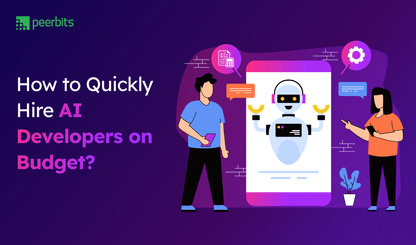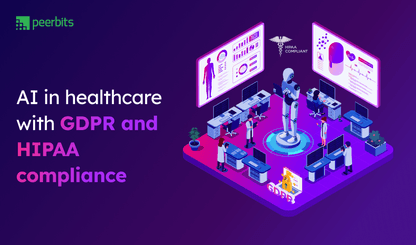AI adoption is growing steadily across industries. If you're planning to build an AI-driven application, one of the first things you'll wonder is the AI software development cost. Questions like How much does an AI app cost? often come up early, but the answer is not always simple.
Whether you are a startup automating support or a business planning predictive tools, understanding AI app development cost in 2025 helps you make better budgeting decisions. Cost depends on more than just coding. It includes app complexity, data preparation, platform choice, development process, and ongoing maintenance. Some factors often get overlooked, like infrastructure, bias checks, retraining, or compliance updates.
This blog explains every cost component clearly, using insights drawn from AI development services to help you plan smarter for your AI journey and avoid unexpected expenses.
AI app development workflow
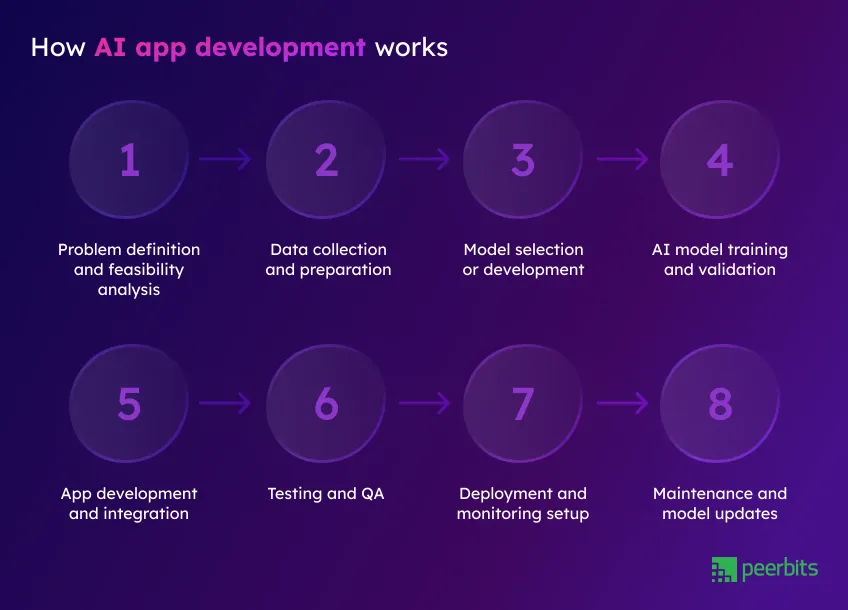
Building an AI-powered app is not a linear process. Each phase connects to the next, and decisions made early on affect everything from AI app development budget to scalability later. Below is an AI app development workflow to help businesses see where time and cost are invested.
1. Problem definition and feasibility analysis
Before writing any code, the development team identifies the business problem, defines clear objectives, and evaluates whether AI is the right fit. This includes scoping potential solutions and checking the availability of usable data.
2. Data collection and preparation
Relevant data is gathered, cleaned, labeled, and structured. Depending on the use case, this could involve scraping public datasets, integrating internal systems, or manually annotating complex inputs.
3. Model selection or development
The team either selects an existing AI model (e.g., a pre-trained language or vision model) or builds a custom one from scratch. They also decide how the model will be integrated into the app logic.
4. AI model training and validation
The selected model is trained using the prepared dataset. The team runs experiments to fine-tune performance, avoid overfitting, and make sure the model works in real-world scenarios.
5. App development and integration
The AI model is integrated into the app’s frontend and backend systems. The team builds the user interface, sets up APIs, and connects the model to real-time data flows.
6. Testing and QA
The full application goes through quality testing for mobile apps. This includes not just bug checks but also AI-specific issues like model drift, bias, and unexpected behavior in edge cases. It helps ensure stable and safe performance before launch.
7. Deployment and monitoring setup
The app is deployed to a cloud environment or on-premise infrastructure. Real-time monitoring is set up to track app performance, model output quality, and system health.
8. Maintenance and model updates
After launch, teams continuously update the app, retrain the model with new data, and adjust for changing business needs. Support for users and troubleshooting are also part of this phase.
Key factors influencing AI app development cost in 2025
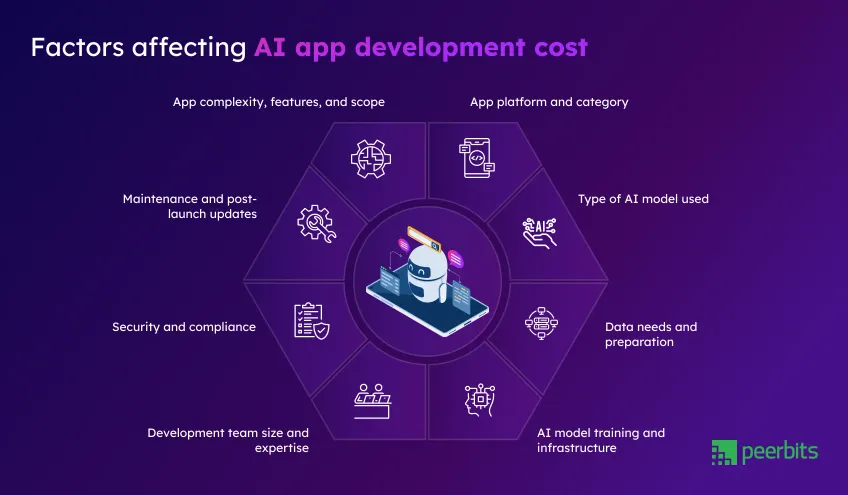
The total cost to build AI application depends on several interconnected variables. These go beyond basic coding, touching on infrastructure, data, compliance, and even long-term operations. Below is Ai cost breakdown of key factors like, such as how much does it cost to build an AI application in 2025.
App complexity, features, and scope
App complexity refers to how many components the app has and how they interact. Features could range from simple automation (like a rule-based chatbot) to advanced functions such as natural language processing, computer vision, or real-time decision-making. Scope includes how broadly the app serves users or integrates with other systems.
The more complex the app, the more important it is to choose the right mobile application development approach from the start as it takes longer development time and more specialized team.
Adding features like AI-based personalization, multilingual support, or voice input often means more AI model integrations, which adds to the budget. For example, AI chatbot development cost is usually much lower than building an AI-driven diagnostic tool for healthcare.
App platform and category
This covers whether the app is being built for web, mobile (iOS/Android), or cross-platform. It also includes the industry type or domain, like healthcare, e-commerce, logistics, or FinTech.
Different platforms have varying development standards, toolkits, and testing needs, which is where the right mobile app development company can add value.
A fintech app might require stronger encryption and auditing features, whereas a retail chatbot may focus more on NLP and recommendation engines.
Type of AI model used
AI models vary from basic rule-based systems to advanced neural networks or generative AI like GPT or diffusion models. Businesses can either use off-the-shelf models (via APIs) or develop custom ones from scratch.
Off-the-shelf models cost less but offer limited customization. Custom model development involves training on domain-specific data, evaluating model performance, and ongoing tuning.
This leads to higher development time and increased costs due to the need for specialized talent and computing power.
Data needs and preparation
AI applications rely heavily on data, raw input that trains the model to recognize patterns or make decisions. Data preparation includes collecting, cleansing, annotating, and organizing it into usable formats.
For models to perform accurately, high-quality and well-labelled data is essential. This preparation can take weeks or months, especially in domains where labelled datasets are hard to find or need manual review (e.g., legal documents, X-rays).
Many businesses underestimate the time and resources required at this stage, which leads to cost overruns.
AI model training and infrastructure
This refers to the process of feeding data into AI algorithms so they learn to perform tasks. It also involves the use of servers, GPUs, and cloud platforms that handle large computations.
Training AI models can be expensive, particularly if custom models are required. Cloud providers like AWS, Azure, and Google Cloud charge for compute time, and GPU-based training adds up quickly.
Tuning, testing, and running multiple experiments extend the timeline and inflate the budget.
Development team size and expertise
This includes the number of developers, data scientists, AI engineers, project managers, and testers involved in the project. It also considers how experienced they are in working with AI tools and frameworks.
AI specialists are in high demand and often command higher salaries or hourly rates. Larger or more skilled teams might accelerate development but also raise upfront costs.
The choice between hiring in-house, working with a development partner, or outsourcing globally also has a direct financial impact.
Security and compliance
Security involves protecting user data, preventing model misuse, and ensuring the app is resistant to attacks. Compliance refers to meeting legal standards such as GDPR, HIPAA, or other regional data protection laws.
Building secure and compliant AI apps requires encryption, access controls, model explainability, and documentation. In regulated industries, third-party audits, certifications, and legal consultation add further costs.
These are often overlooked in early planning when teams ask, How much does AI app cost?
Maintenance and post-launch updates
AI apps need ongoing updates to stay relevant. This includes retraining models with new data, fixing bugs, ad apting to user feedback, and updating dependencies or platform compatibility.
Initial development is only part of the expense. AI models may degrade in performance over time if not updated with fresh data.
Companies must budget for recurring work such as model retraining, cloud storage, software upgrades, and security patches to keep their app running reliably.
Read more: Build Generative AI applications on AWS
Hidden and overlooked costs
AI app development budgets often miss expenses like hardware (GPUs, servers), third-party APIs, licensing fees, usability testing, bias audits, localization, and ongoing updates based on user feedback. These factors can add significant costs over time.
Hardware
AI models, especially deep learning ones, need powerful hardware like GPUs or TPUs for training and deployment. Renting or buying this infrastructure can be a significant ongoing expense.
Third-party services & APIs
Using external AI services and APIs speeds up development but usually comes with usage-based fees. These costs can increase as the app scales or usage grows.
Licensing fees for tools
Some AI development tools and platforms require paid licenses, which may be monthly or yearly. These fees add to the total cost, especially for enterprise-level features.
UX research & usability testing
User experience testing ensures the app is easy and effective to use. This phase requires dedicated time and resources to gather feedback and make necessary improvements.
Bias testing & ethical AI audits
Checking AI models for bias and fairness is critical to avoid legal and reputational risks. Specialized audits and testing may be required, adding to the budget.
Localization and region-specific customization
Adapting the app to different languages, cultures, or regulations takes extra development work. This is important for apps targeting global or diverse markets.
User feedback loops & feature iterations post-launch
After launch, collecting user feedback and making continuous improvements helps the app stay relevant. These ongoing updates should be planned and budgeted from the start.
AI app building cost breakdown by type
AI app building cost varies by the type and complexity of the solution. Basic apps are quicker and cheaper to build, while advanced solutions using custom AI models, vision systems, or generative capabilities require more time, specialized talent, and infrastructure.
| AI App Type | Typical Features | Estimated Cost | Development Time |
|---|---|---|---|
| Basic | Rule-based chatbot, smart filters | $10,000 – $50,000 | 2 to 3 months |
| Mid-level | Recommendation systems, NLP-based search | $50,000 – $150,000 | 4 to 6 months |
| Advanced | Computer vision, predictive models, generative AI | $150,000 – $500,000+ | 6 to 12+ months |
Strategies to optimize cost
Smart cost-saving comes from open-source tools, MVP-first builds, outsourcing, and automation. Planning compliance early and using modular development also help reduce expenses.
- Use open-source models and libraries like Hugging Face or LangChain.
- Begin with an MVP to test ideas faster with less risk.
- Outsource to experienced developers in budget-friendly regions.
- Automate testing to reduce manual effort and time.
- Use cloud spot instances or shared infrastructure for training.
- Include compliance planning from the start to avoid rework.
- Follow modular development: build in small, testable sprints.
AI development cost: Product’s estimated insights
These examples offer insights into AI product cost based on real applications. From chat platforms to generative tools, they highlight how features and scale impact AI application development pricing.
| AI App | Estimated Development Cost | Development Time | Key Features |
|---|---|---|---|
| ChatGPT (OpenAI) | $500,000 – $1 million+ | 6–12+ months | Advanced language model, conversational AI, extensive training on diverse datasets |
| Google Bard | $3 billion+ (operational costs) | Ongoing | Conversational AI integrated with Google's search infrastructure |
| IBM Watson Assistant | $140/month (Plus plan) | Varies | Enterprise chatbot solutions with natural language understanding |
| Synthesia | $120,000 – $500,000 | 4–8 months | AI-driven video generation with synthetic avatars and voiceovers |
| MidJourney | $50,000 – $500,000 | 3–6 months | AI-powered image generation based on textual prompts |
How businesses can calculate AI development costs
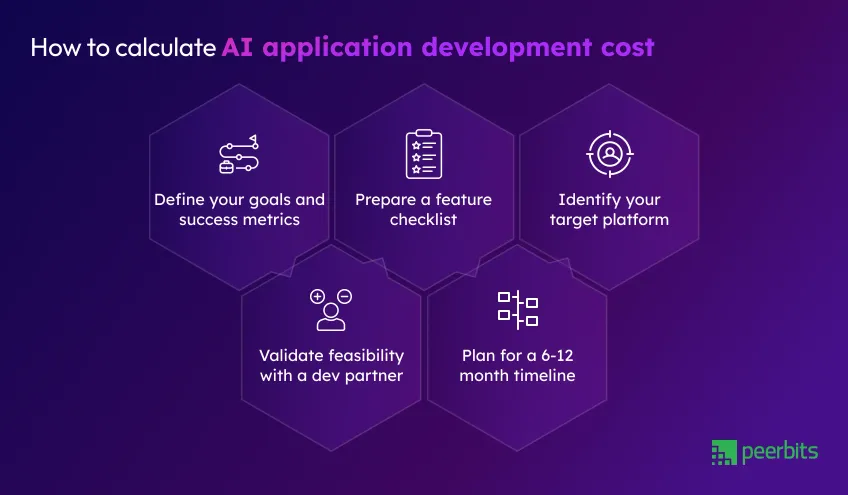
Getting a reliable cost estimate for your AI app means breaking the project down into clear parts. These steps can guide you toward a more realistic budget:
Define your goals and success metrics
Be specific about what you want your AI app to do. Whether it's automating support, improving search, or generating content, setting measurable goals helps shape the scope and cost from the start.
Prepare a feature checklist
List the key features you want like chat, image analysis, recommendation engines, or dashboards. Knowing the AI and non-AI parts early gives developers a clearer picture of effort needed.
Identify your target platform
Decide whether the app will run on mobile, web, or both. Platform choice affects UI design, development time, testing, and overall cost.
Validate feasibility with a dev partner
Before moving ahead, it’s helpful to hire AI developers or consult with a team that has delivered similar projects. They can flag technical limitations, refine your roadmap, and suggest ways to reduce unnecessary spend.
Plan for a 6-12 month timeline
Serious AI apps, especially those using custom models, typically need several months for proper design, development, training, and testing. Rushing may lead to poor outcomes or extra rework.
Conclusion
Understanding the true AI app development cost in 2025 goes beyond just coding. Factors like data preparation, infrastructure, compliance, and ongoing maintenance all impact your budget. Careful cost estimation and clear AI project planning help avoid unexpected expenses and keep your development on track.
Whether building a basic chatbot or an advanced predictive system, knowing where resources will be spent improves decision-making. Working with a trusted partner that provides AI consulting services can offer valuable insights and help turn your ideas into realistic budgets.
By planning thoughtfully and considering all cost factors, businesses can better manage their investment and deliver AI applications that meet their goals without surprises.

FAQs
Costs can rise due to data quality issues, extended model training time, additional compliance needs, or complex integration with existing systems. Planning ahead and thorough analysis can help reduce surprises
Different AI technologies require varying levels of maintenance, such as frequent retraining for models that handle changing data or updating APIs from third-party services, which can affect long-term expenses.
Key roles include AI engineers, data scientists, frontend/backend developers, and QA specialists. Balancing expertise and team size based on project needs helps control costs while maintaining quality
Yes. Besides computing resources, hidden costs may include data storage, network bandwidth, API usage fees, and costs for monitoring and scaling infrastructure.
Complying with regulations like GDPR or HIPAA may require extra effort in data handling, security audits, and legal consultation, which should be factored into the project budget.
Yes. Launching an MVP with core AI features allows validation of business value before investing in advanced capabilities, helping manage budgets more effectively.
Look for partners with proven experience, transparent AI application pricing, and a clear development process. Also, check their expertise in your industry and ability to offer scalable solutions.


